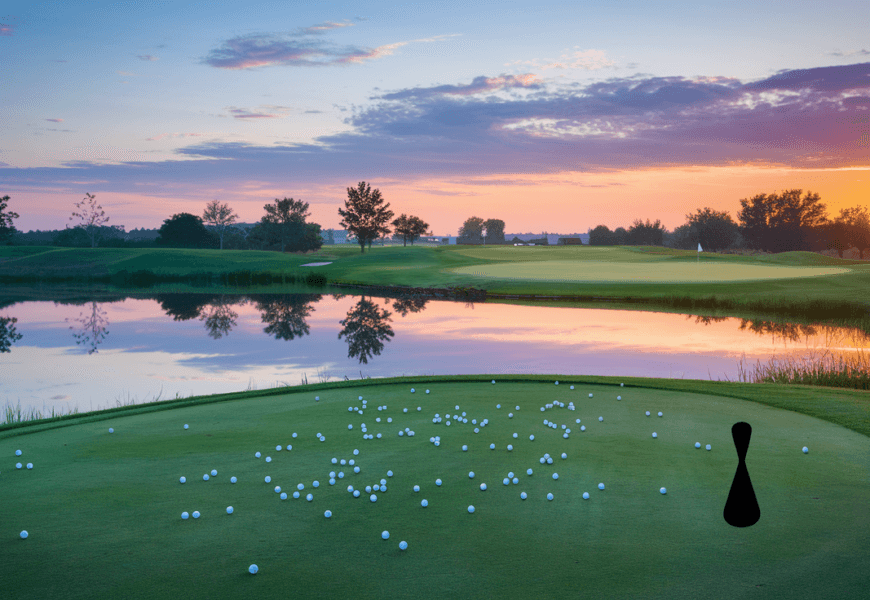Choosing the Right Golf Ball
Let’s talk about something every golfer knows: finding the right golf ball can change your whole game. Whether aiming to whack it further than ever or nail that precision shot, the ball you choose is a game-changer.
Why Your Golf Ball Choice Matters
We’re diving into why picking the right golf ball makes a difference. A ball’s performance hinges on stuff like how squishy it is, the shape of its dimples, and how it’s put together. Everyone has their vibe on the course, and the perfect ball can play to your strengths or make up for where you struggle. Want to hit it further? Look for a ball that tickles your fancy with just the right mix.
| Key Features | More Distance | Better Control | Nice Feel |
|---|---|---|---|
| Squishiness | Stiff | Sorta Stiff | Soft |
| Dimples | Big | Tiny | Middle-sized |
| Layers | Two | Three | Multiple |
Know these things, and you’ll pick a ball that sticks to your game like white on rice.
Finding Your Match
Hooking up the right golf ball with your style needs a bit of thinking about things like how fast you swing, how much spin you like, and how the ball feels overall.
Swing Speed:
- If you’re swinging slower, go for the softer balls. They feel good, fly higher, and don’t spin wildly, helping you zip down the fairway. If you want to dig deeper, Cattail Crossing talks about compression.
- In the middle-speed club? You might dig two- or three-layer balls, like the swinging Titleist Pro V1, for a nice throw between distance and control.
- Vroom goes your swing? You’ll want the four- and five-piece balls for steady spin control and pizzazz.
Preferred Spin:
- Low-spin balls can get you way down the fairway.
- High-spin balls are your pals for spot-on control and extra spin.
Overall Feel:
- Just starting or playing for fun? Two-piece balls won’t bust the bank, and they go far. Give Golfballs.com’s insights a look here.
- If you’re rocking it with some experience, three-piece balls might be your jam—better feel, more grip on your shots, Cattail Crossing agrees (link).
For ideas that match you even more, peek at our pieces on personalized golf balls and top picks for everyday golfers.
Mull over these tips and find that special ball that speaks to your golf game.
Factors Affecting Golf Ball Performance
Let’s chat about what really makes a golf ball tick—or fly, in this case—with just the right zing. Two big spoilers in this game are the ball’s squashiness (or compression) and those little dimples you see dotting its surface.
Impact of Compression on Distance
When it comes to compression, we’re talking about how squishy the ball gets when you whack it. The squish rating goes from 30 (think marshmallow soft) to 120 (rock hard), and nailing this choice can really ratchet up your game. If you’re swinging like a pro with some serious speed, a tougher ball might suit you just fine. It’s all about nailing that sweet spot and sending the ball rocketing with razor-sharp control and spin. But be warned, you might trade a bit of distance for that precision.
| Compression Rating | Benefits | Ideal Swing Speed |
|---|---|---|
| 30-50 (Soft) | Nice feel, higher launch, less wild sideways spin | Slow (under 85 mph) |
| 70-90 (Medium) | A good mix of length and control | Medium (85-100 mph) |
| 100-120 (Hard) | Sharp control, more spin action | Fast (over 100 mph) |
Now, if you’re not swinging like you’re trying to break records, lean toward the softer balls. They’ll spring more on impact, giving ’em a boost in speed and length. Plus, they lift higher and steady out that spin, giving weekend putters extra distance they can appreciate.
For those scratching their heads about which squish level suits their swing best, our detailed compression guide spills all.
Understanding Dimple Design
Who knew dots could be so important, right? Those dimples on your golf ball are like its little turbochargers, making sure it slices through the air just right. Typically, golf balls rock around 300 to 500 dimples at an average depth akin to a sliver—0.010 inches. These little guys work magic, cutting drag and letting the ball soar further. Smooth balls, by comparison, just kinda…well, flop.
| Dimple Count | Average Depth (inches) | Effect on Flight |
|---|---|---|
| 300-500 | 0.010 | Best lift and less drag |
Tiny tweaks—and we’re talking as small as 0.001 inch—in dimple depth can twist and turn the ball’s path in ways you’d notice on the fairway. Picking the right dimple design is like choosing the right socks for a marathon—it just shouldn’t be overlooked.
If you’re out to hit the longest with extra flying power, wrapping your head around the dimple talk is worth its weight in gold. Peek into our guide on choosing the right golf ball and check out how dimples can change your golf game, especially if you’re pursuing those long drives, by glancing at our tips for finding the ideal golf balls for far-reaching shots.
Best Golf Balls for Distance
Picking the right ball for golf might be the magic touch your game needs. Want to see that ball fly real far? Check these top picks, each with its own perks to match different game styles.
Srixon Distance Golf Ball
Need both distance and control? Check out the Srixon Distance ball. Its softer core lets you launch it like a rocket, with a flight path like it’s got its own GPS. Plus, it’s good with short game finesse, perfect for newer players.
| Spec | Details |
|---|---|
| Compression | Soft |
| Launch | High |
| Flight | Laser-like |
For golfers aiming to boost distance without losing control, Srixon Distance is a winner. If you’re curious about more balls for players learning the ropes, don’t miss our guide on best golf balls for high handicappers.
Titleist Velocity Golf Ball
Titleist Velocity is built for pure distance thrills. Featuring a new pattern of dimples and a snazzy ionomer cover wrapped around a fast core, it launches high, stays steady, and hugs the wind.
| Spec | Details |
|---|---|
| Dimples | Octahedral |
| Cover | NaZ+ Ionomer |
| Core | High Velocity LSX |
Personally, I reckon Titleist Velocity nails distance without sacrificing playability. For low-spin alternatives, don’t miss our section on low spin golf balls.
Bridgestone e9 Golf Ball
Crafted with the World Long Drive pros, Bridgestone e9 rockets off the tee. With 330 dimples, it’s all about epic launch and consistency, fueled by a smart core for zippy speeds.
| Spec | Details |
|---|---|
| Dimples | 330 |
| Core | Gradational |
| Launch | Sky-high |
A great pick for those who crave big hits and steady play. For more budget-friendly options, explore our section on cheap golf balls in bulk.
Callaway Warbird Golf Ball
Callaway’s Warbird means business with distance and speed. Its two-piece makeup and huge, energetic core make it pop higher and go longer, especially great for newbies and those refining their game.
| Spec | Details |
|---|---|
| Build | Two-piece |
| Core | High-energy |
| Best For | Beginners, high handicappers |
Callaway Warbird’s ruggedness across games is impressive. For beginner-focused recommendations, check our guide on golf balls for beginners.
TaylorMade Distance+ Golf Ball
TaylorMade Distance+ boasts a dimply aerodynamic pattern and a core designed for speed and low-drag action. Its cover offers solid control for short range while keeping a nice mid-launch trajectory.
| Spec | Details |
|---|---|
| Dimples | 342 |
| Core | REACT Speed |
| Play | Mid-launch |
Perfect for golfers who want to mix up speed, distance, and finesse. If you’re a senior, we have more suggestions on golf balls for seniors.
Wilson Distance Golf Ball
Wilson Distance is made for those longing for length in every smack. A large energetic core revs up speed, while a tough outer ensures it lasts through many swings.
| Spec | Details |
|---|---|
| Core | High-energy |
| Goal | Distance |
| Durability | Sturdy |
Wilson’s option is tailor-fit for players who wanna max out length off the tee. For those who like colorful options, check colored golf balls.
In sizing up these golf balls based on how they’re built, their core, and what they’re good for, you’re ready to find the one that suits your swing. Each brings something to the table to help you stretch those yards on the green.
Picking Your Perfect Golf Ball
Let’s talk about one big deal when you’re hunting for the best golf balls for distance: golf ball compression. Yeah, it’s a mouthful, but understanding it can seriously up your game. I’ll break down how compression changes the way your ball behaves and help you pick the right one for your swing speed.
What’s the Deal with Compression?
Alright, so golf ball compression is all about numbers. They tell you how much the ball squishes when you whack it. A lower number, around 70, means the ball’s softer; higher, like 110, means it’s tougher (GolfBalls.com). When you hit the ball, it squishes against your clubface, and that squishiness impacts both how far it goes and how well you can control it.
Low-compression balls are like trampolines; they give you more bounce and are great if your swing isn’t setting speed records. On the flip side, high-compression ones are for folks who swing like they’re angry – they need faster speeds but award you with more control (GolfBalls.com). Here’s a cheat sheet for you:
| Squish Rating | What It Means | Best When You Swing At | What It Does for You |
|---|---|---|---|
| 70-80 | Squishier | Less than 85 mph | Fly farther, feel softer |
| 80-90 | In-Between | 85-100 mph | Balance of distance and control |
| 90-110+ | Tough | Over 100 mph | More command, less squish |
Your Swing Speed’s Best Buddy
Compression choice is totally about how fast you swing. If you’re clueless about your speed, pop into a golf shop or range nearby and get it checked out. Here’s how to pick:
Slow-Mo Swinger (Under 85 mph): Your slower swing pals well with low-compression balls. They squash more when hit, sending them further. Peek at our picks for golf balls for beginners and golf balls for seniors for some options.
The Average Joe (85-100 mph): You land in a sweet spot where medium and sometimes high-compression balls might fit the bill. Try a mix to see which jives with how you play and what feel you like.
Fast and Furious (Over 100 mph): You need high-compression balls. They’re tougher and give the precision needed at your speed, with a solid feel.
For one-on-one advice, swing by our user preferences and experiences page. Nailing the feel-performance balance can change your game big time. Curious how a golf ball’s build tweaks spin or length? Check our high spin golf balls and low spin golf balls pages.
Exploring Multi-Layered Balls
Trying to find that perfect golf ball to suit your swing? Well, buckle up because we’re diving into the nitty-gritty about what makes each type tick. We’re talking two-piece, three-piece, and the fancy four or five-piece golf balls. Strap in for the scoop that’ll help you step up your game.
Benefits of Two-Piece Golf Balls
Two-piece golf balls are the “go-to” for those learning the ropes or folks with a higher handicap. Imagine a golf ball that rockets off the tee and doesn’t forget to help out with your short game. Oh, and your wallet won’t hate you either. They’re pretty much the budget-friendly heroes of the golf world (Source).
Key Features:
- Solid core for boosting your drives
- Tough skin for a long-lasting partnership
- Friends with frugal golfers
| Feature | Two-Piece Golf Balls |
|---|---|
| Distance | High |
| Spin Control | Just enough |
| Feel | On the stiffer side |
| Cost | Easy on the pocket |
They’re perfect for anyone trying to get that extra yardage. And if you’re stockpiling on a budget, these are your pals. Hit up cheap golf balls in bulk for deals.
Advantages of Three-Piece Golf Balls
Now, stepping up to three-piece golf balls, you’ll find a different kind of magic—like hitting a sweet spot between power and finesse. These balls are popular amongst those with above-average skills, blending distance with a softer feel, which means better control around the greens (Source).
Key Features:
- Core adds yardage
- Middle layer ups the spin game
- Urethane cover for that soft touch
| Feature | Three-Piece Golf Balls |
|---|---|
| Distance | A fine balance |
| Spin Control | Cranked up |
| Feel | Soft and smooth |
| Cost | Not cheap but not crazy either |
For those who enjoy a little bit of everything, three-piece balls are your ticket. They don’t skimp on performance, making them a solid choice for golfers who like control and feel. Got special needs? Check out golf balls for beginners or golf balls for seniors.
Performance of Four and Five-Piece Golf Balls
At the top of the heap are the four and five-piece deals. These babies are for the advanced players who demand precision, high spin, and feel like you’re hitting a cloud. They’re the Rolls Royce of golf balls—pricey but packed with perks (Source).
Key Features:
- Complex layers for top-tier performance
- Short game spin so good, it feels like cheating
- Super durable, like they’ll stick around forever
| Feature | Four and Five-Piece Golf Balls |
|---|---|
| Distance | Top-notch |
| Spin Control | Off the charts |
| Feel | Like butter |
| Cost | Better save up |
For the pros and those swinging fast like a hurricane, these multi-layered balls offer control that makes even the toughest shots a breeze. Looking for the big leagues? Brands like Titleist Pro V1 can be your new best friend (Cattail Crossing). For those wanting a bit of flair, explore our personalized golf balls or colored golf balls.
So there you have it. Choosing the right multi-layer golf ball is your ticket to nailing those long drives and sinking those tricky putts. Remember, the right choice can give you the edge you crave out there on the green.
Personal Recommendations and Insights
Choosing the right golf ball isn’t just about getting the distance; it’s more like finding the perfect dance partner that matches your rhythm on the green. Based on what I’ve experienced and heard from others, here’s some handy info on picking what suits you best, balancing that all-important feel and performance.
User Preferences and Experiences
Every golfer out there has their ‘two cents’ when it comes to choosing golf balls. Some folks love ’em for sending shots far and wide, while others swear by the ones that obey more like a well-trained dog. For example, those who swing like a tornado with high speeds often find themselves liking higher compression balls. They promise better accuracy and control, as confirmed by a study from Cattail Crossing.
If you’re just teeing up in the sport or swinging with a higher handicap, you might wanna check out two-piece golf balls. They’re a solid starting point, pushing distance and handling spin decently, cited right over at Golfballs.com. But old-timers or experienced swingers might say these balls shoot up unpredictably on iron shots and play a wild game off the putters, per the folks over at GolfWRX.
| Ball Type | Who It’s For | What It’s Got |
|---|---|---|
| Two-piece | Beginners, High Handicappers | Distance galore, short game spin, easy on the wallet |
| Three-piece | Intermediate, Experienced | Spins like a smooth criminal, better feel, soft as butter |
Balancing Feel and Performance
For those who want both feel and performance, those three-piece balls got your back. They’re built to chill on your long game while giving you that nice spin and control on short hits (GolfWRX). Personally, I’m a fan of a three-piece’s soft touch. The Wilson Spin is my jam for a comfy and balanced ride.
Players with monster swings will need high compression balls, possibly knocking around the 120 mark, whereas gentler swingers might find solace in softer options near a compression rating of 30. This choice zips you to a fine tune of performance control (Cattail Crossing).
To truly know what suits ya, experiment with different types and see how they laugh or cry under various course conditions. For a personal touch, check out some tips on personalized golf balls.
Tuning your game means lining up your ball choice with your playing vibe, swing speed, and all those weather elements that love to play tricks on the course. The right pick could bring more joy to your play and leave you grinning after every swing. If you’re torn between feel and performance, look into low spin golf balls or high spin golf balls, depending on whether you’re chasing more distance or tighter control.


